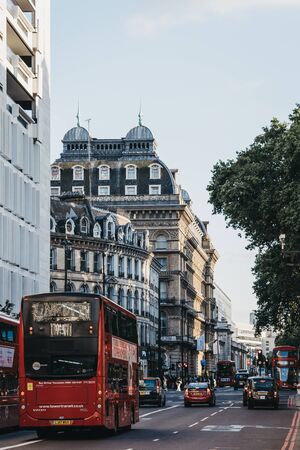Introduction to Londons Congestion Charge
Since its launch in 2003, the London Congestion Charge has become a defining feature of the capitals approach to tackling traffic congestion and air pollution in the city centre. The scheme was introduced by Transport for London (TfL) as a bold response to chronic gridlock, with the primary aim of reducing vehicle numbers within key central areas during peak business hours. Over the years, the Congestion Charge has evolved, reflecting shifts in urban mobility, environmental priorities, and public attitudes towards sustainable transport.
The charge zone covers much of Central London, including iconic districts such as Westminster and the City of London. By imposing a daily fee on most vehicles entering this area, the policy incentivises motorists to seek alternative modes of transport—such as cycling, walking, or using the extensive public transit network. This strategy not only alleviates pressure on the roads but also supports broader city goals related to air quality and urban liveability.
Below is a summary of key facts about the Congestion Charge scheme:
| Feature | Details |
|---|---|
| Introduced | February 2003 |
| Administered by | Transport for London (TfL) |
| Main Objective | Reduce congestion and improve air quality in Central London |
| Coverage Area | Central London (approx. 21 sq km) |
This introductory overview sets the stage for understanding the detailed rules, costs, and exemptions associated with Londons Congestion Charge, which we will explore in subsequent sections.
2. How the Congestion Charge Works
The Congestion Charge is a scheme introduced by Transport for London (TfL) to reduce traffic congestion within the heart of the capital. Understanding how it operates is crucial for anyone driving into central London. Below, we break down the essential rules, including charging zones, operating hours, and payment methods.
Charging Zones
The Congestion Charge covers a defined area in Central London, commonly referred to as the Congestion Charge Zone (CCZ). The boundaries are clearly marked with road signs featuring a white ‘C’ in a red circle. The main locations within this zone include key landmarks such as Westminster, Soho, Holborn, and the City of London.
| Key Areas Within CCZ | Notable Landmarks |
|---|---|
| Westminster | Big Ben, Houses of Parliament |
| Soho | Oxford Street, Leicester Square |
| Holborn | The British Museum |
| City of London | St Pauls Cathedral, Bank of England |
Operating Hours
The charge applies only during specific times:
| Day | Operating Hours |
|---|---|
| Monday–Friday | 07:00–18:00 |
| Saturday–Sunday & Bank Holidays | 12:00–18:00 |
No charges apply between Christmas Day and New Year’s Day inclusive.
How to Pay the Charge
There are several convenient ways to pay the Congestion Charge:
- Online: Payments can be made through the official TfL website or via their mobile app.
- Auto Pay: Register your vehicle for automatic billing and receive a discount on daily charges.
- Telephone: Payment can also be made over the phone by contacting TfL directly.
Payment Deadlines & Penalties
You must pay by midnight on the third charging day after travel. Failure to do so results in a Penalty Charge Notice (PCN), which carries a significant fine if not settled promptly.
Summary Table: Key Points at a Glance
| Aspect | Description |
|---|---|
| Zone Coverage | Main central London districts only; check TfL maps for details. |
| Operating Hours | M-F 07:00–18:00; Weekends/BH 12:00–18:00; Not charged Christmas–New Year. |
| How to Pay | TfL online/app, Auto Pay (discounted), telephone service. |

3. Costs and Payment Methods
Breakdown of Daily Charges
The London Congestion Charge applies a standard daily rate for most vehicles driving within the charging zone between 07:00 and 18:00, Monday to Friday, and 12:00 to 18:00 on weekends and bank holidays. It is essential to check if your journey falls within these times, as charges are not applicable outside of these hours.
| Type | Daily Charge |
|---|---|
| Standard Rate (online/autopay) | £15.00 |
| Same Day Payment (by midnight) | £17.50 |
| Auto Pay Discounted Rate | £10.50 |
For frequent visitors, registering for Auto Pay can help save money by providing a discounted rate and ensuring you never miss a payment deadline.
Penalties for Non-Payment
If you fail to pay the Congestion Charge by midnight on the third charging day after travel, you will receive a Penalty Charge Notice (PCN). The penalty is £160, but it is reduced to £80 if paid within 14 days. Delayed payments will incur the full penalty amount and persistent non-payment may result in further enforcement actions.
| Penalty Type | Amount | Reduction for Early Payment |
|---|---|---|
| Standard PCN | £160 | £80 (if paid within 14 days) |
Accepted Payment Platforms
The Congestion Charge offers several convenient payment methods tailored to both UK residents and international visitors:
- TFL Online Portal: Pay directly via the Transport for London website using debit or credit cards.
- Auto Pay: Set up an account for automatic payments, ideal for regular drivers in central London.
- TFL Phone App: Make quick payments or manage your account on-the-go through the official TFL app.
- PayPoint Outlets: Cash or card payments are accepted at participating retailers across Greater London.
- Telephone Payments: Call the TFL customer service line to pay over the phone with your card details.
Payment Reminders and Tips
If you’re visiting from abroad or don’t frequently drive in central London, consider setting up reminders or enrolling in Auto Pay to avoid unexpected penalties. Always keep proof of payment until your visit concludes, as this may be required in case of disputes.
4. Exemptions and Discounts
Understanding the various exemptions and discounts available for London’s Congestion Charge is crucial for drivers who wish to minimise costs or avoid charges altogether. The system is designed not only to manage traffic but also to encourage greener transport options and support individuals with specific needs. Below is a comprehensive review of who qualifies for these benefits.
Who Can Apply for Exemptions?
Several groups are eligible for full exemptions from the Congestion Charge. These include:
- Blue Badge Holders: Individuals registered under the Blue Badge scheme can apply for a 100% discount, even if they do not drive themselves, as long as the vehicle is being used for their benefit.
- Taxis and Private Hire Vehicles: Licensed black cabs and private hire vehicles meeting certain criteria are exempt when actively carrying passengers or en route to pick them up.
- Emergency Service Vehicles: Official vehicles such as ambulances, police cars, and fire engines are fully exempt.
Discounts for Residents
Residents living within the Congestion Charge zone can benefit from a substantial discount. This concession recognises that those living in central London have limited alternatives and may need to use their vehicles more regularly.
| Eligible Group | Discount Rate |
|---|---|
| Residents within zone | 90% |
Ultra-Low Emission Vehicles (ULEVs)
The scheme also incentivises environmentally friendly choices. Owners of ULEVs, including fully electric and some plug-in hybrid vehicles, may qualify for a cleaner vehicle discount. However, it’s important to note that eligibility criteria are subject to periodic updates by Transport for London (TfL).
| Vehicle Type | Discount/Exemption |
|---|---|
| Fully Electric Vehicles | Cleaner Vehicle Discount (currently 100%) |
| Plug-in Hybrid Vehicles* | May qualify (check TfL eligibility) |
*Eligibility depends on CO2 emissions and electric-only range; always confirm via TfL before travelling.
Special Circumstances and Additional Considerations
- Certain NHS patients and staff working in central London may be eligible for reimbursement schemes through their trusts.
- Buses registered with TfL are universally exempt.
A Note on Application Processes
Most discounts and exemptions require an application via the official TfL website, with supporting documentation. It’s advisable to apply well in advance of travel, as processing times may vary.
5. Impact on Londoners and Commuters
The Congestion Charge has had a significant impact on the daily lives of Londoners, businesses, and commuters within Greater London. This section provides a professional analysis of its effects across key sectors:
Impact on Local Drivers
For private vehicle owners residing or commuting into the charging zone, the Congestion Charge has introduced both financial and behavioural changes. Many drivers now reconsider unnecessary trips into Central London, opting instead for alternative routes or public transport to avoid the daily fee. The table below summarises some key impacts:
| Aspect | Impact |
|---|---|
| Cost per Day | £15 (standard charge) |
| Behavioural Change | Increase in carpooling, shift to public transport |
| Commuter Routes | Avoidance of congestion zone during charging hours |
Business Implications
The introduction of the charge has compelled many businesses—especially those relying on logistics and deliveries—to adjust their operational strategies. While some report increased costs due to daily charges, others have observed improved delivery times thanks to reduced traffic congestion. Small businesses often feel the pinch more acutely than large corporations with greater resources.
Main Effects on Businesses
- Increased operational expenses for deliveries and staff commuting by car
- Potential savings from quicker transit times within the zone
- Adoption of electric vehicles to benefit from exemptions
Public Transport Usage
A notable outcome of the Congestion Charge is its positive influence on public transport usage. Transport for London (TfL) data indicates a substantial rise in bus, tube, and cycling journeys since the charge was implemented. This modal shift not only alleviates road congestion but also supports environmental targets.
| Mode of Transport | Change Since Charge Introduction |
|---|---|
| Buses | +10% ridership increase |
| Tubes/Underground | +7% ridership increase |
| Cycling | +20% journey increase in central areas |
Sustainability Benefits
- Lower emissions in central London zones
- Healthier lifestyle encouraged through cycling and walking initiatives
Conclusion: A Mixed Bag for Residents and Commuters
The Congestion Charge continues to shape urban mobility patterns, presenting both challenges and opportunities for Londoners. While it imposes additional costs for drivers and some businesses, it also drives innovation in logistics and supports cleaner, more sustainable travel options throughout Greater London.
6. Tips for Navigating the Congestion Zone
Successfully navigating London’s Congestion Charge zone requires a blend of careful planning and savvy use of alternatives. Here are some practical strategies to help you avoid fines, streamline your journey, and embrace transport options favoured by locals.
Avoiding Fines: Key Steps
- Check Your Route: Use Transport for London’s (TfL) online tools or mobile apps to confirm whether your route enters the Congestion Charge zone. The boundary is clearly signposted, but digital route planners can help you steer clear if you wish.
- Pay Promptly: Payment must be made by midnight on the day of travel. Set up Auto Pay with TfL to ensure you never miss a payment and benefit from reduced daily rates.
- Understand Camera Coverage: Automatic Number Plate Recognition (ANPR) cameras monitor all entry points, so there’s no slipping through unnoticed. Always assume you’re being tracked once inside the zone.
Planning Your Journey: Best Practices
- Travel Off-Peak: The charge applies between 7:00 and 18:00 Monday to Friday and 12:00 to 18:00 weekends and bank holidays. Consider travelling outside these hours when possible.
- Use Perimeter Car Parks: Park just outside the zone and complete your journey via public transport or walking.
Popular Alternative Transport Options
| Mode | Description | Benefits |
|---|---|---|
| London Underground & Overground | Extensive network covering most of Greater London | No congestion charge; frequent service; fast cross-city travel |
| Buses | Comprehensive routes, including Night Bus services | No charge; affordable with Oyster/Contactless card; bus lanes beat traffic |
| Cycling | Santander Cycles hire scheme available throughout central London | No charge; healthy; avoids traffic jams; abundant docking stations |
| Walking | Pavements and pedestrian zones in key areas | No cost; environmentally friendly; often quicker over short distances |
Local Insight: Embracing London’s Transport Culture
Londonders typically combine multiple forms of transport—cycling to a Tube station, then hopping on a bus—to optimise journeys both in terms of time and cost. Adopting this flexible approach will not only help you avoid charges but also immerse you in the authentic rhythm of city life.
7. Future Developments and Policy Changes
As London continues to tackle traffic congestion, air quality, and sustainability, significant changes are on the horizon for the Congestion Charge and related schemes. Keeping abreast of these future developments is essential for motorists, businesses, and residents alike.
Proposed Changes to the Congestion Charge
The Mayor of London and Transport for London (TfL) regularly review the Congestion Charge to ensure it meets the city’s evolving needs. Recent consultations have explored adjustments such as:
- Extending operating hours further into evenings and weekends
- Dynamic pricing based on real-time congestion levels
- Increasing daily rates to encourage greater use of public transport
ULEZ Expansion and Integration
The Ultra Low Emission Zone (ULEZ), which operates alongside the Congestion Charge Zone, has seen significant expansions in recent years. The most notable was the August 2023 expansion to cover all London boroughs. The city is considering further integration between ULEZ and Congestion Charge systems, potentially introducing a single payment platform or harmonising exemptions.
| Scheme | Current Coverage | Potential Change |
|---|---|---|
| Congestion Charge | Central London | Extended hours/zones under review |
| ULEZ | All London boroughs | Further emissions standards tightening possible |
What Should Londoners Expect?
- More seamless digital payment systems and mobile app integration
- Increased incentives for electric vehicles (EVs) and car-sharing schemes
- Tighter enforcement on non-compliant vehicles entering restricted zones
The Road Ahead for Policy Evolution
Larger environmental goals—such as achieving Net Zero by 2030—are driving these policy shifts. Residents should anticipate more ambitious measures targeting high-polluting vehicles and promoting active travel options like cycling or walking. Stakeholder engagement remains crucial; thus, TfL frequently invites public feedback before implementing major changes.
The next few years will likely bring not only stricter regulations but also enhanced support for greener alternatives, positioning London as a global leader in sustainable urban mobility.


